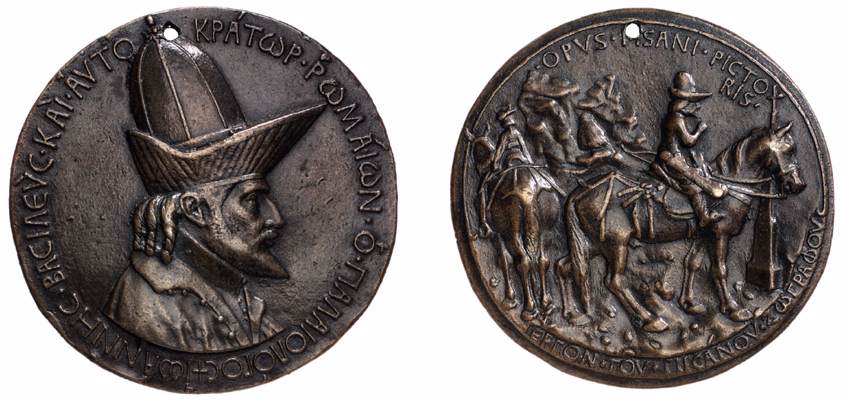
by Andrew Montiveo
Antonio di Puccio Pisano, known as Pisanello (c. 1395 – c. 1455), crafted this portrait medal of John Palaeologus (Basileus Iôannês Palaiologos), the penultimate emperor of Byzantium, sometime between 1438 and 1442. Art historians generally refer to the portrait as the first of its kind, setting forth a precedent adopted by later rulers, including Sultan Mehmed II of Ottoman Turkey and Emperor Charles V of the Holy Roman Empire. The total number of copies of this medal is unknown, but examples are on display at several sites, including the British Museum in London, the Metropolitan Museum of Art in New York, and the National Gallery of Art in Washington.
The medal, measuring about four inches in diameter, was the first of at least a dozen that Pisanello crafted over the span of a decade. The obverse side displays a profile portrait of Iôannês, bearded and wearing a domed and peaked cap; a Greek inscription reads: “Ἰωάννης Βασιλεύς καί Αὑτοκρἀτωρ Ῥωμαἰων ό Παλαιολόγός.” The reverse side depicts Iôannês on horseback; Pisanello’s credit is inscribed in Latin overhead (“Opus Pisani Pictoris”) and Greek underneath (“Ἕργον του Πισἀνου Ζωγρἀφου”). The obverse reading acknowledges John’s claim to Roman emperorship, despite approximately six and a half centuries of competing claims from the Latin Holy Roman Empire.
Pisanello created the medal to commemorate Iôannês’s tour of Italy. The purpose of the emperor’s visit was to negotiate the reunification of the Western Latin and Eastern Orthodox churches after nearly four centuries of schism. The work is an example of the heightened realism Italian artists achieved by the fifteenth century, the most refined seen in Europe since the third. By the time of the Byzantine Empire’s formation in the fourth century, Western statuary took on an increasingly abstract form.
Combined with other contemporary depictions, notably Benozzo Gozzoli’s Il Processione dei Magi, Iôannês’s likeness is the most certain of Byzantine emperors. Sadly, his empire met its demise when it fell to Sultan Mehmed II in the spring of 1453. Over the course of four decades, Bertoldo di Giovanni, Pietro da Milano, Bertoldo di Giovanni, and Costanzo de Ferrara created portrait medals of the Turkish sultan, all following the lead of Pisanello’s portrait of John.

